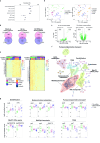Dual RNA sequencing of a co-culture model of Pseudomonas aeruginosa and human 2D upper airway organoids
- PMID: 39824906
- PMCID: PMC11742674
- DOI: 10.1038/s41598-024-82500-w
Dual RNA sequencing of a co-culture model of Pseudomonas aeruginosa and human 2D upper airway organoids
Abstract
Pseudomonas aeruginosa is a Gram-negative bacterium that is notorious for airway infections in cystic fibrosis (CF) subjects. Bacterial quorum sensing (QS) coordinates virulence factor expression and biofilm formation at population level. Better understanding of QS in the bacterium-host interaction is required. Here, we set up a new P. aeruginosa infection model, using 2D upper airway nasal organoids that were derived from 3D organoids. Using dual RNA-sequencing, we dissected the interaction between organoid epithelial cells and WT or QS-mutant P. aeruginosa strains. Since only a single healthy individual and a single CF subject were used as donors for the organoids, conclusions about CF-specific effects could not be deduced. However, P. aeruginosa induced epithelial inflammation, whereas QS signaling did not affect the epithelial airway cells. Conversely, the epithelium influenced infection-related processes of P. aeruginosa, including QS-mediated regulation. Comparison of our model with samples from the airways of CF subjects indicated that our model recapitulates important aspects of infection in vivo. Hence, the 2D airway organoid infection model is relevant and may help to reduce the future burden of P. aeruginosa infections in CF.
Keywords: Pseudomonas aeruginosa; 2D co-culture; Airway organoids; Dual RNA-sequencing; Infection model; Quorum sensing.
© 2025. The Author(s).
Conflict of interest statement
Declarations. Competing interests: HC is the head of Pharma Research and Early Development at Roche, Basel and holds several patents related to organoids technology. HC’s full disclosure is given at https://www.uu.nl/staff/JCClevers/. The other authors declare no conflict of interest.
Figures






Similar articles
-
Evaluating Bacterial Pathogenesis Using a Model of Human Airway Organoids Infected with Pseudomonas aeruginosa Biofilms.Microbiol Spectr. 2022 Dec 21;10(6):e0240822. doi: 10.1128/spectrum.02408-22. Epub 2022 Oct 27. Microbiol Spectr. 2022. PMID: 36301094 Free PMC article.
-
RhlR-Regulated Acyl-Homoserine Lactone Quorum Sensing in a Cystic Fibrosis Isolate of Pseudomonas aeruginosa.mBio. 2020 Apr 7;11(2):e00532-20. doi: 10.1128/mBio.00532-20. mBio. 2020. PMID: 32265330 Free PMC article.
-
LasR Variant Cystic Fibrosis Isolates Reveal an Adaptable Quorum-Sensing Hierarchy in Pseudomonas aeruginosa.mBio. 2016 Oct 4;7(5):e01513-16. doi: 10.1128/mBio.01513-16. mBio. 2016. PMID: 27703072 Free PMC article.
-
The role of quorum sensing in chronic cystic fibrosis Pseudomonas aeruginosa infections.FEMS Microbiol Lett. 2009 Jan;290(1):1-9. doi: 10.1111/j.1574-6968.2008.01394.x. Epub 2008 Oct 29. FEMS Microbiol Lett. 2009. PMID: 19016870 Review.
-
Pseudomonas aeruginosa hypoxic or anaerobic biofilm infections within cystic fibrosis airways.Trends Microbiol. 2009 Mar;17(3):130-8. doi: 10.1016/j.tim.2008.12.003. Epub 2009 Feb 21. Trends Microbiol. 2009. PMID: 19231190 Review.
Cited by
-
Nasal microbionts differentially colonize and elicit cytokines in human nasal epithelial organoids.bioRxiv [Preprint]. 2025 Apr 30:2024.09.25.614934. doi: 10.1101/2024.09.25.614934. bioRxiv. 2025. PMID: 39386636 Free PMC article. Preprint.
-
Establishment and characterization of persistent Pseudomonas aeruginosa infections in air-liquid interface cultures of human airway epithelial cells.Infect Immun. 2025 Mar 11;93(3):e0060324. doi: 10.1128/iai.00603-24. Epub 2025 Feb 18. Infect Immun. 2025. PMID: 39964154 Free PMC article.
-
Organoid-on-a-chip (OrgOC): Advancing cystic fibrosis research.Mater Today Bio. 2025 Jul 28;34:102148. doi: 10.1016/j.mtbio.2025.102148. eCollection 2025 Oct. Mater Today Bio. 2025. PMID: 40791795 Free PMC article. Review.
References
-
- Quinton, P. M. Cystic fibrosis: Impaired bicarbonate secretion and mucoviscidosis. Lancet372, 415–417 (2008). - PubMed
-
- Kunzelmann, K., Schreiber, R. & Hadorn, H. B. Bicarbonate in cystic fibrosis. J. Cyst. Fibros.16, 653–662 (2017). - PubMed
-
- Forbes, E. & Abu-Sbaih, R. Cystic fibrosis. Nat. Rev. Dis. Primers. 10.1038/nrdp.2015.49 (2015).
-
- De Boeck, K. Cystic fibrosis in the year 2020: A disease with a new face. Acta Paediatr. Int. J. Paediatrics. 109, 893–899 (2020). - PubMed
MeSH terms
Grants and funding
LinkOut - more resources
Full Text Sources
Molecular Biology Databases

